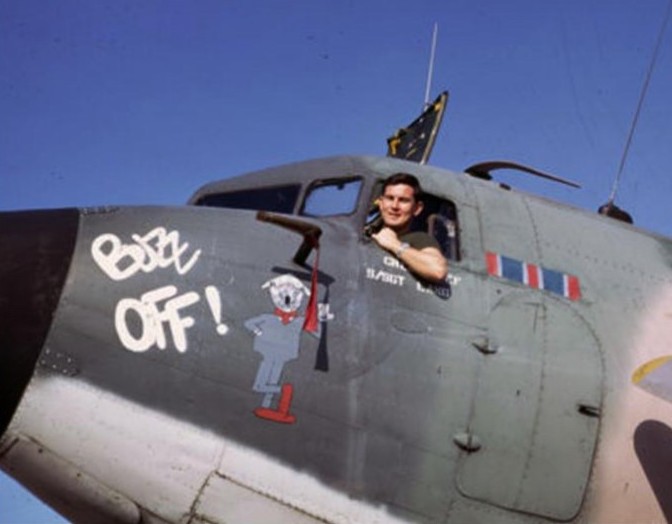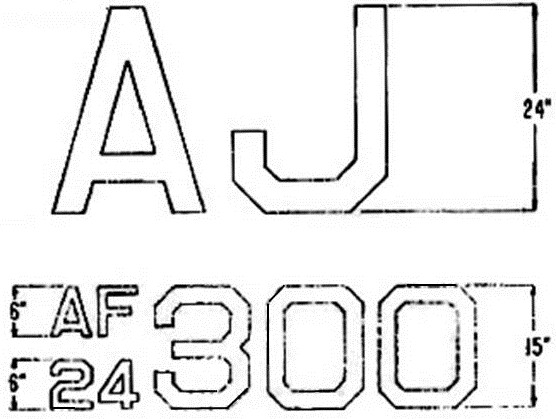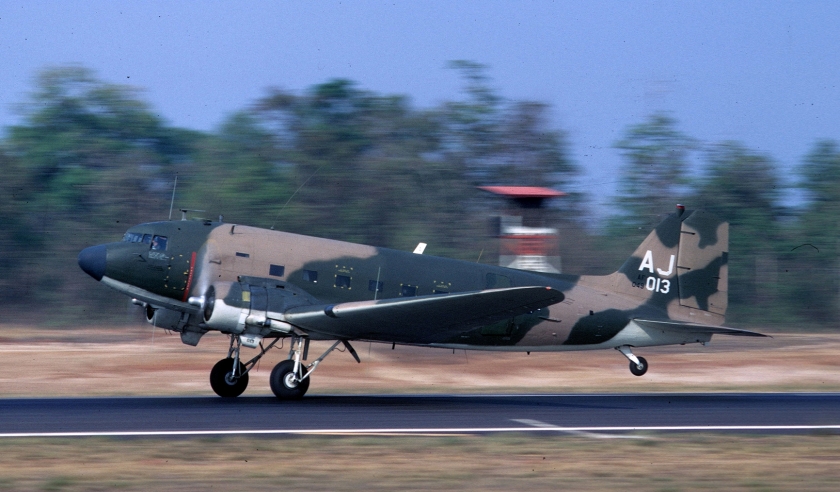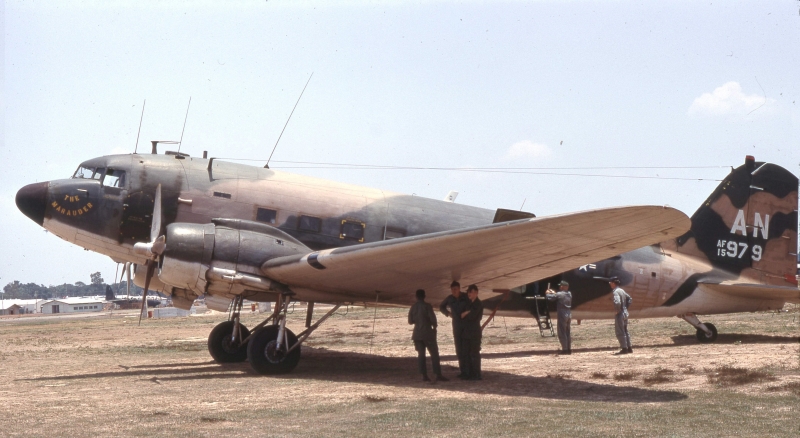USAF Camouflage for Southeast Asia
Around 1966 the USAF began camouflaging its combat aircraft and most of the colorful schemes of the 1950s and early 60s disappeared. The new camouflage was commonly referred to as the “Southeast Asia Scheme.” Technical Order 1-1-4, Exterior Finishes, Insignia and Markings Applicable to Aircraft and Missiles, prescribed topside colors as two shades of green mixed with patches of tan, with the undersides a shade of cream gray. For reasons unknown, and contrary to the T.O. requirements, the undersides of EC-47 aircraft, including landing gear, flaps, wheel caps and wheel wells were painted a semi-gloss white rather than the prescribed gray.
T.O. 1-1-4 also contained rough diagrams illustrating camouflage patterns for individual aircraft types. But the diagrams below, extracted from the instruction sheet provided with a set of 1:72 scale model decals produced by an English company in the early 1970s, provide a more accurate rendition of the appearance of an actual aircraft than the generic T.O. 1-1-4 sketch. (The letters refer to placment of small decals relating to the "Andy Capp" nose art.) The T.O. called for colors to be matched to Federal Standard 595, Colors Used in Government Procurement. The colors below are as close to actual paint chips as digital approximation will allow.
EC-47 43-15603 "Buzz Off" of the 360th TEWS, ca. mid-1969

Undersides Semi-Gloss White
EC-47 radomes were generally painted flat black, although on some aircraft the green and white of the adjacent fuselage area was carried over to the radome. Particularly early on, a few planes had black rectangles painted under the nose, about half the width of the fuselage and extending to approximately the leading edges of the wings. (See, for example, the view below.) Propellers were aluminum with 4” yellow tips (FS-595 color 33538). The Hamilton Standard logo was affixed to each blade, about half way between the hub and the tip. Various information stencils appeared in approximately 1” high black lettering, although the aircraft data under the left side pilot’s window was sometimes in white. (See photos below.) Areas of the fuselage which could be cut by ax-wielding emergency rescue personnel were outlined with dashed yellow stripes and with “Cut here for emergency rescue” stenciled in yellow. A miniaturized version of the national star insignia (15” diameter star) was applied to both sides of the fuselage, the upper left and lower right wings.
The Real Deal
Here are two photos of 43-15603, obviously taken some time apart. (The left view is dated 17 July 69.) Notice the difference in radome appearance and the absence of the propeller warning stripe. The ribbon for the USAF Outstanding Unit Award was painted (both sides) just behind the cockpit side window. Andy Capp was a newspaper cartoon character of the day, whose favorite expression was "buzz off".
 |
The Andy Capp nose art was still in place in early 1970, but was painted over soon thereafter, apparently along with the many other examples within the EC-47 fleet. This aircraft, presumably minus the QRC-346 gear, was turned over to the VNAF in 1972. Its ultimate fate is unknown.
Tail Codes and Serial Number Markings
 |
Beginning about 1967, Pacific Air Forces (PACAF) began assigning two-letter tail codes to units in Southeast Asia. (Prior to that, no tail codes were carried.) The squadrons attached to the 460th Reconnaissance Wing, headquartered at Tan Son Nhut, were given codes beginning with “A”. The TEWS were assigned codes as follows: 360th AJ; 361st AL; 362nd AN. The poor quality image extracted from T.O. 1-1-4 illustrates the basic dimensions for the Tail Code/Serial Number block. Code letters were white, 24 inches in height. "AF" and the first two digits of the serial number were in black, 6" high, with the last three digits in 15" white letters. This serial number presentation makes it difficult to positively identify an aircraf in the Southeast Asia camouglage scheme, particularly in types of WWII vintage, which frequently carried serial numbers totaling seven digits.* |
Color Photos
The photographs which follow illustrate the Southeast Asia camouflage scheme as it was applied to the EC-47 fleet from about 1968 on. Aircraft from all three TEWS are represented. However, the aircraft were rotated out of country for periodic maintenance or Inspection and Repair as Necessary (IRAN). This sometimes involved repainting as part of corrosion control. When an N or P model aircraft returned to SEA, it could be reassigned to a different TEWS. Because of the unique requirements of the ALR-38 system and R-2000 engine, the EC-47Qs were assigned only to the 362nd TEWS and later, when Seventh Air Force stood down to Thailand, to the 361st.

EC-47N 43-49013 of the 360th TEWS on takeoff roll at NKP.
The 360th rotated aircraft from Tan Son Nhut to NKP on a regular basis.
Note the slight pattern mismatch on the fin/rudder.

A pristine EC-47P (45-1046) of the 361st TEWS on the Phu Cat Ramp.
Note the leaflet chute installed in the rearmost window.
The difference between the two shades of green camouflage is barely discernable.

An interesting shot of EC-47N 43-15979 assigned to the 362nd TEWS.
Note the overlap of the AN code and serial number on to the rudder, the touched-up area
on the forward fuselage,and the absence of the propeller warning stripe.
* For explanation of the USAAF's WWII serial number system, see EC-47 Serial Numbers and Data elsewhere on the site.
Article by Joe Martin
30 July 2015
Photo credits: Norm Taylor
